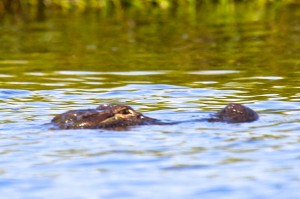Over the past couple weeks; I have had the opportunity to go on a couple trips with Don to the Black River located in Bladen County, NC. This river offers plenty of beautiful wildlife including wild turkey, deer, several types of ducks, and wildflowers. The Black River is also home to the Three Sisters Swamp where you can find some of the oldest recorded cypress trees in the country. Although these trees are not marked, for their own protection, with an experienced guide such as Don, you will be able to see some amazing old growth cypress trees in this swamp that have been dated to being over 2,000 years old. Paddling through this swamp truly is a majestic experience. Being able to get up close and personal with these ancient cypress trees gave me a deeper connection to this swamp. In ways this swamp inspired me by showing me no matter how hard these trees have been hit and beaten by countless hurricanes, high winds, floods, and other natural disasters, they still stand tall and strong after all those years.
One of the most memorable parts of both these trips included seeing the beautiful spider lilies bloom. This is a special phenomenon here in eastern North Carolina because these plants only bloom for about two weeks out of the year. But what a spectacular experience it is to be able to see these plants bloom during their short flowering period. It’s trips like these which make me realize how lucky we are to be able to experience gods creation and enjoy the natural beauty of many diverse eco systems from a kayak.
Don & Diane Harty own Mahanaim Adventures. They specialize in helping families and groups to have “Positive & Memorable” outdoor adventures. Whether these are wildlife view adventure, camping adventure or a simple kayaking adventure. They provide kayaking adventures on Town Creek, Cape Fear River, Fort Fisher Basin, Masonboro Island, Black River, Holly Shelter Creek and Moores Creek. Contact them at www.mahanaimadventures.com for more information about all of their adventures.
This blog was written by Mike Manning. I am Mahanaim Adventures new intern for the summer of 2018. I am a Park and Recreation Management student at East Carolina University, Go Pirates! I love the outdoors and have a strong passion for kayaking. This coming summer I will be writing a blog similar to this every other week to let everyone know about the awesome adventures we will have on the water this summer.

